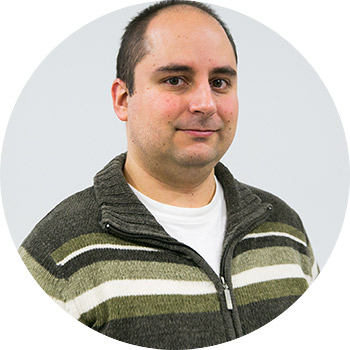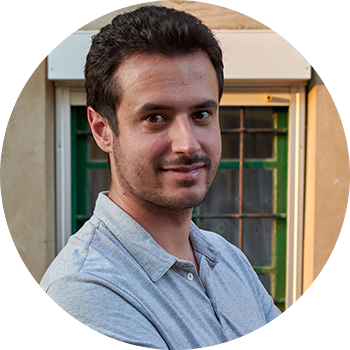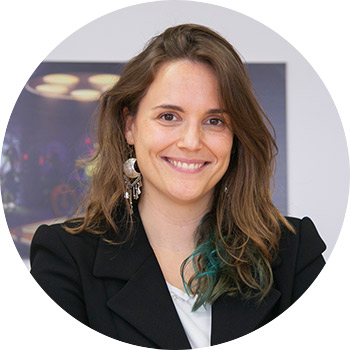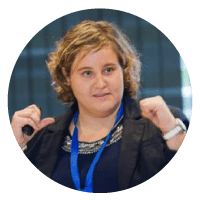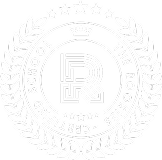The CIGNVS Lab research group was created with the aim of strengthening and advancing research around computer graphics systems, extended realities, GPU rendering, immersive data visualization and virtual simulations. These are all topics that are currently on the rise in the industry. The members of the group have more than 30 JCR publications, 47 articles in national and international conferences and 60 publications of books or book chapters.

Dr. Marcos Novalbos
Dr. José Jesús García Rueda
Phd. Candidate David Pinto
Phd. Candidate Álvaro San Juan
Dr. Gonzalo Nicolás
Cristina Ruiz Poveda
| Multi-technique Redirected Walking Method. J Mayor, L Raya, S Bayona, A Sanchez. IEEE Transactions on Emerging topics in Computing 19(2). 2022. |
| A Novel Mixed Reality Solution based on Learning Environment for Sutures in Minor Surgery. A. Rojo, L. Raya, A. Sánchez,. Applied Sciences. 2021. |
| A comparative Study of Virtual Reality Methods of Interaction and Locomotion bades on presence, Cybersickness and Usability. J Mayor, L Raya, A Sánchez. IEEE Transactions on Emerging topics in Computing. 9 (3) 2021 |
| Interactive Visual Clustering and Classification based on Dimensionality Reduction Mappings: A Case Study for Analyzing Patients with Dermatologic Conditions Expert Systems With Applications A. Mohedano-Muñoz, S.Alique-garcía, M.Rubio-Sánchez, L. Raya, A. Sánchez. Expert Systems with Applications (ESWA). 2021. |
| Virtual Reality Application for Fostering Interest in Art. L Raya, JJ García-Rueda, D López-Fernández, J Mayor. IEEE Computer Graphics and Applications 41 (2), 106-113. 2021 |
| Virtual Trasplant Reality: Herramienta Psicológica que promueve el bienestar emocional y mejora la calidad de vida de los niños con trasplante pediátrico y sus familias. Erika Guijarro, Laura Raya, José Jesus García Rueda, María Jose Pascau. XXV Congreso de la Sociedad Española de Pediatría Social. 2021 |
| Improving the Discriminability of Haptic Icons: The Haptic Tuning Fork. Laura Raya, Sara. A. Boda, Marcos Garcia, Sofia Bayona. Applied Sciences. 2021. |
| Development of pressure boundaries for fluids in virtual surgery. Alba Peris, Laura Raya. SPANISH COMPUTER GRAPHICS CONFERENCE. 2021. |
| Performance evaluation of lower limb exoskeletons:a systematic review. D Pinto-Fernandez, D Torricelli, M del Carmen Sanchez-Villamanan,…IEEE Transactions on Neural Systems and Rehabilitation Engineering 28 (7). 2020 |
| Feature selection based on star coordinates plots associated with eigenvalue problems. Alberto Sánchez, Laura Raya, Miguel A. Mohedano, Manuel Rubio. The Visual Computer. 2020. |
| Motivation of computer science students at universities organized around small groups. D López-Fernández, E Tovar, L Raya, F Marzal, JJ Garcia. 2019 IEEE Global Engineering Education Conference (EDUCON), 1120-1127. |
| A Virtual Reality Training Application for Adults with Asperger’s Syndrome. D Rojo, J Mayor, JJG Rueda, L Raya. IEEE Computer Graphics and Applications 39(2), 104-111. 2019. |
| Project Based learning Meets Service Learning on Software Development Education. Daniel López, Laura Raya, Fernando Ortega, José Jesús García. The International Journal of Engineering Education. 2019 |
User characteristics on the virtual reality presence Jesús Mayor, Alberto Sánchez, Laura Raya SPANISH COMPUTER GRAPHICS CONFERENCE. 2018. |
| A visual interface for feature subset selection using machine learning. D. Rojo, L. Raya, M. Rubio, A. Sánchez. SPANISH COMPUTER GRAPHICS CONFERENCE (CEIG2018). Madrid. |
| Hybrid Collaborative Filtering based on Users Rating Behavior. Fernando Ortega, Diego Rojo, Paola Valdiviezo-Díaz, Laura Raya. IEEE Access. 2018. |
| Acomparative study between radviz and star coordinates. M Rubio-Sánchez, L Raya, F Diaz, A Sanchez. IEEE transactions on visualization and computer graphics. 22 (1), 619-628. 2016. |
Challenges of digital advertising from the study of the influencers’ phenomenon in social networks, Ruiz-Poveda Vera, Cristina. en Corporate Communications: An International Journal. Admitido a publicación. 2022
|
The Ultimate Border: Mobility, Spirituality, and Death in Iñárritu’s Biutiful Ruiz-Poveda, Cristina. en Hispanic Research Journal. 2022.
|
An Unconventional Zombie: Subcultural Genres, Global Art Cinema, and Bio-power in Sebastian Hofmann’s Halley (2012), Ruiz-Poveda, Cristina. en New Cinemas: Journal of Contemporary Film. 2020. |
Ágata’s (Filmmaking) Friends: Contemporary Women Directors in Catalonia Ruiz-Poveda, Cristina. en The Routledge Companion to European Cinema, ed. Gábor Gergely. Routledge. Diciembre 2021.
|
We are the wolfpack: Teenagers and animality in contemporary European cinema. Ruiz-Poveda, Cristina. Gendercom: VIII International Conference on Gender and Communication. Universidad de Sevilla y Universitá degli studi della Tuscia, 2022. |
The Queer Crip Witch Wins: A Return to Animality in Blue my Mind and Thelma. Ruiz-Poveda, Cristina. X Congreso internacional GECA: Cine queer en elm undo. Universidad Complutense de Madrid, 2022. |
Negociando con la feminidad: adolescentes y animales en el cine iberoamericano contemporáneo. Ruiz-Poveda, Cristina. Mujeres y cine en Iberoamérica (congreso TECMERIN). Universidad Carlos III de Madrid, 2022. |
Girls gone wild: Animality and teenage female bodies in contemporary European cinema. Ruiz-Poveda, Cristina. Screen Studies Conference. University of Glasgow, 2022. |
Flashbacks, Transnationalism, and Intrahistory in La guerre est finis. Ruiz-Poveda, Cristina. British Association of Adaptation Studies. Queen Margaret University, 2021. |
Immersive Embodiment and the Drag: Dissociation and Visual Pleasure in Los ojos de Mila Kaos. Ruiz-Poveda Vera, Cristina y Sabina, Julia. “British Association of Film, Television, and Screen Studies Conference. University of Southhampton, 2021. |
Monitoring Human-Exoskeleton Interaction with Multimodal Interfaces and AI. David Pinto. Programa de Doctorado Automática y Robótica (UPM). Directores: Diego Torricelli y Eduardo Rocón. Último año.
Análisis y perfeccionamiento de los métodos de interacción y locomoción en entornos de Realidad Virtual. Jesús Mayor. Programa de Doctorado Tecnologías de la Información y las Comunicaciones (URJC). Directores: Laura Raya (U-tad) y Alberto Sánchez (URJC). Sobresaliente Cum Laudem en septiembre 2020.
CicerOn
Virtual Speech Coach (Co-professorship with Indra and Fundación Universia)
The realism and immersion capacity of virtual reality allows its application to not be restricted to recreational applications, but to assume an important role in psychology as well as in therapies and treatments for certain phobias. This project proposes the use of virtual reality as a training tool to assess university students with different levels of Asperger’s.
In this way, it is proposed that this program will help students with special needs in their educational performance, leveraging gamification and virtual reality to break the barrier of social interaction.
- Laura Raya (Project Director)
- José Jesús García Rueda (Head of Immersive Education)
- Diego Rojo (Former student with a Master’s in Computer Graphics)
- Jesús Mayor(Development Supervisor.)
- Luis Alberto Vázquez(Art Supervisor)
- Fátima Escalante (Master’s student in Computer Graphics, Virtual Reality, and Simulation)
- Damian García (Student Expert in Development for Virtual, Augmented, and Mixed Reality)
- Javier Rojo (Former student with a Master’s in Computer Graphics, Virtual Reality, and Simulation)
- Jaime López (Student with a Degree in Animation)
- Raul Boldu (Student with an Expert degree in Development for Virtual, Augmented, and Mixed Reality)
- Andrea García (Student with a degree in Visual Design)
- Gregorio Iniesta (Master’s student in Computer Graphics and Simulation)
- Eugenio Salguero (Master’s student in Computer Graphics and Simulation)
A Virtual Reality Training Application for Adults With Asperger’s Syndrome.
Rojo D, Mayor J, Rueda JJG, Raya L,
IEEE Computer Graphics and Application. 2019 Mar-Apr;39(2):104-111. doi: 10.1109/MCG.2018.2884272.
SCI JCR 1.64. Q2.
A Comparative Study of Virtual Reality Methods of Interaction and Locomotion Based on Presence, Cybersickness, and Usability.
Jesús Mayor, Laura Raya and Alberto Sánchez. IEEE Transaction on Emerging Topics in Computing. 2019. SCI JCR 3,626, Q1.
Support by:


Reactive
Neurocognitive rehabilitation with Virtual Reality in the Pediatric Intensive Care Unit.
Prolonged stays in the pediatric ICU can cause different disorders, such as delirium. The lack of attention, unresponsiveness and neurocognitive absence causes delayed recovery and worsens the patient’s quality of life. In this research project, carried out in collaboration with the Hospital Universitario de La Paz, we propose a new non-pharmacological method to help the patient improve and overcome the state of delirium through the use of virtual reality and emotional and motor rehabilitation therapies.
- Cristina Verdú (Directora del Proyecto)
- Laura Raya (Directora del Grupo Tecnológico del Proyecto)
- Elena Pérez (CoDirectora del Proyecto)
- Erika Guijarro (Investigadora)
- Marc Fabian (Desarrollador Unity. Alumno del Máster Universitario en Computación Gráfica, Realidad Virtual y Simulación)
- Juan Jesús Ruiz (Desarrollador Unity. Alumno del Máster Universitario en Computación Gráfica, Realidad Virtual y Simulación)
- Adrian Ron (Desarrollador Unity. Alumno del Máster Universitario en Computación Gráfica, Realidad Virtual y Simulación)
- Javier García (Desarrollador Web. Alumno de Ingeniería del Software).
- Gustavo Chico (Diseñador Inmersivo. Alumno del Experto en Desarrollo para Realidad Virtual, Aumentada y Mixta)
- Carlos Arnal (Desarrollador Web. Alumno del Máster Universitario en Computación Gráfica, Realidad Virtual y Simulación)
Support by:


Lancelot
The systematic regulation of people with autism is one of the most important milestones to be achieved so that autistic people can lead a normal and accessible life within everyday environments in society. Their daily life is limited by the uncontrolled stress that can be caused by ordinary circumstances such as a noisy city, interacting with animals or being in small spaces.
The use of Virtual Reality as a controlled treatment by a specialist can facilitate such stress regulation by simulating individually tailored situations that can be defined by the user. Using bio-indicators, the user’s own physical condition will determine progress in this virtual reality application.
- Laura Raya (Project Director)
- José Jesús García Rueda (Project Co-Director)
- Jesús Mayor (Development Supervisor)
- Luis Alberto Vázquez (Art Supervisor)
- Miguel Gazón (Student with an Expert degree in Development for Virtual, Augmented, and Mixed Reality)
- Antonio Diaz (Former student with a Master’s in Computer Graphics and Simulation)
- Nadia Parra (Student with a focus in Professional Animation)
- Ellis Joel Rivera (Student with a degree in Animation)
- Study of the influence of user characteristics on the virtual reality presence.
Jesús Mayor, Alberto Sánchez, Laura Raya. CEIG – Spanish Computer Graphics Conference (2018). Virtual Reality as a therapy tool for Autism Spectrum Disorder.
Laura Raya CEIG – Spanish Computer Graphics Conference (2018).
Support by:


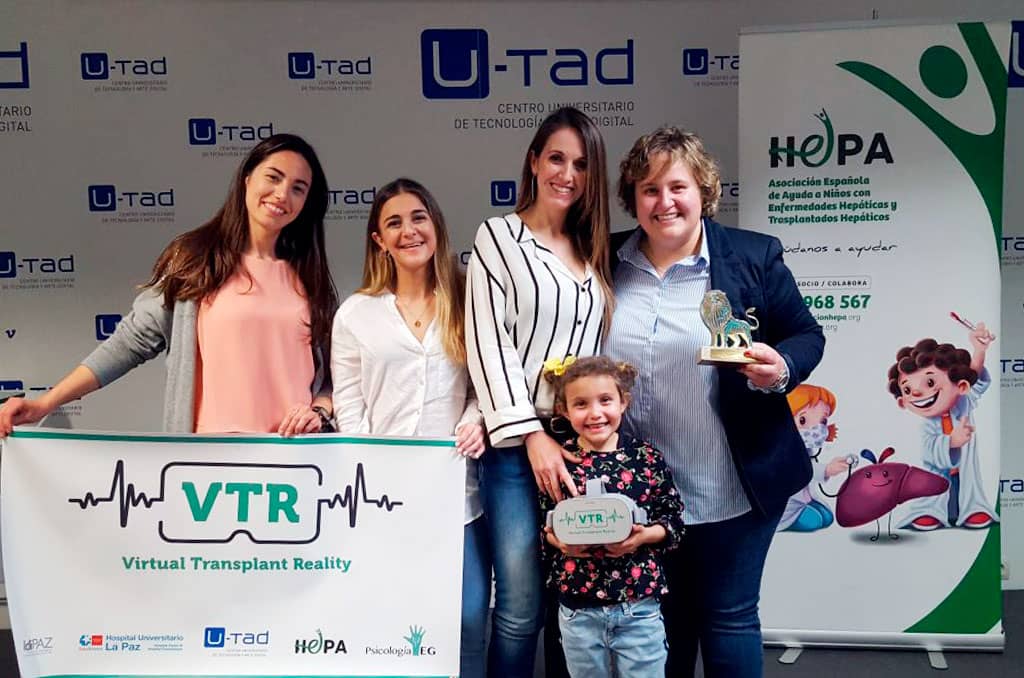
Virtual Transplant Reality
With the help of IdiPAZ, the HePA Association, and promoted by the expert psychologist in VR treatments, Erika Guijarro, this pioneering project aims to develop the first Virtual and Augmented Reality platform for the psychological care of children and adolescents with transplants.
Prevention (anticipating different scenarios): the aim is to train children in stressful or potentially traumatic situations such as stays in the ICU or complicated diagnostic tests, which usually produce a lot of distress and anxiety.
Distraction (pain distraction therapies or pain management): the aim is to change the attention focus of the pediatric patient so they focus on the stimuli provided by this tool instead of on the medical tests.
Awareness (self-care and adherence to treatment): adherence to treatment is encouraged in both patients and their environment (friends, family, etc.) by involving them in the routines of the child with transplants (medical tests, admissions, surgeries, stays in Intensive Care Units, etc.).
Support by:




Comunidad3s
With the help of the Centro Dramático Nacional (the National Drama Center), we incorporate immersive interaction in theatrical work, revolutionizing and changing the role of the passive spectator towards a new vision of an active spectator who is capable of influencing the script through technology. Engineering students and Designers from U-tad worked in this multidisciplinary project, proposing new scenic alternatives with the help of the CDN research laboratory. In collaboration with directors Rakel Camacho, Pilar G. Almansa and David Martínez Sánchez, the project proposes how the concept of community has been transformed by the emergence of social networks.
Support by:

Cenizas (Ashes)
Every day, audiences consume more and more media news of attacks and wars, with an increasing degree of coldness and low empathy, perceiving such news as something distant and alien. Moreover, the large number of first-person shooter videogames inspired by wars or catastrophes is causing youth to become desensitized to these real-life events, as they become used to playing in war-like environments, getting points by beating other players virtually or gaining game experience by killing a larger number of virtual avatars. This lack of in-game empathy is gradually being reflected in a colder society that shows little empathy to environments different from its own.
The Cenizas (Ashes) project aims to use Virtual Reality to foster empathy towards the civilians who experience the consequences of war in a videogame. Through the experiences of a child, Cenizas Virtual Reality shows how an environment of war and death, even if it is virtual, has direct consequences on the community that suffers it.
- Laura Raya (Project Director)
- Jesús Mayor (Development Supervisor)
- Alonso Rosado (Former Master’s student in Computer Graphics and Simulation)
- Germán Rodriguez (Former Master’s student in Computer Graphics and Simulation)
- Veronica A. Rodriguez (Former student with a Certificate in Production for Virtual and Augmented Reality)
- Tomé Ricardo (Animation Student)
- Celia Arranz (Animation student)
- Vicky Vicent (Student with a Degree in Interactive Product Design)
- Amaia (Animation student)
- Lucía (Animation Student)
InmersArte
The observation and understanding of art is not always easy for students and non-experts. Moreover, there is a growing and evident lack of interest among young people in art and museums, which prevents us from proposing an attractive and innovative learning alternative.
The InmersArte Project—which has the support of the Ministry of Education, Culture, and Sport—proposes an educational tool that allows users to experience art interactively through the use of virtual reality.
Instead of passively observing a painting, the user becomes part of it, navigating through the work with the Oculus VR headset. In this way, the user is able to recreate and explore every single corner of the painting.
- Laura Raya (Project Director)
- Diego Corcuera (Former Master’s student in Computer Graphics and Simulation)
- Leire Foguez (Former Master’s student in Computer Graphics and Simulation)
- José Luis Garrido (Former student with a degree in Animation)
- Iván Izquierdo (Former student with a degree in Visual Design).
- Jaime Repollés (Project Art Supervisor)
The Use of Virtual Reality in Educational Environments.
Laura Raya. Workshop ArtFutura (2016).
Support by:

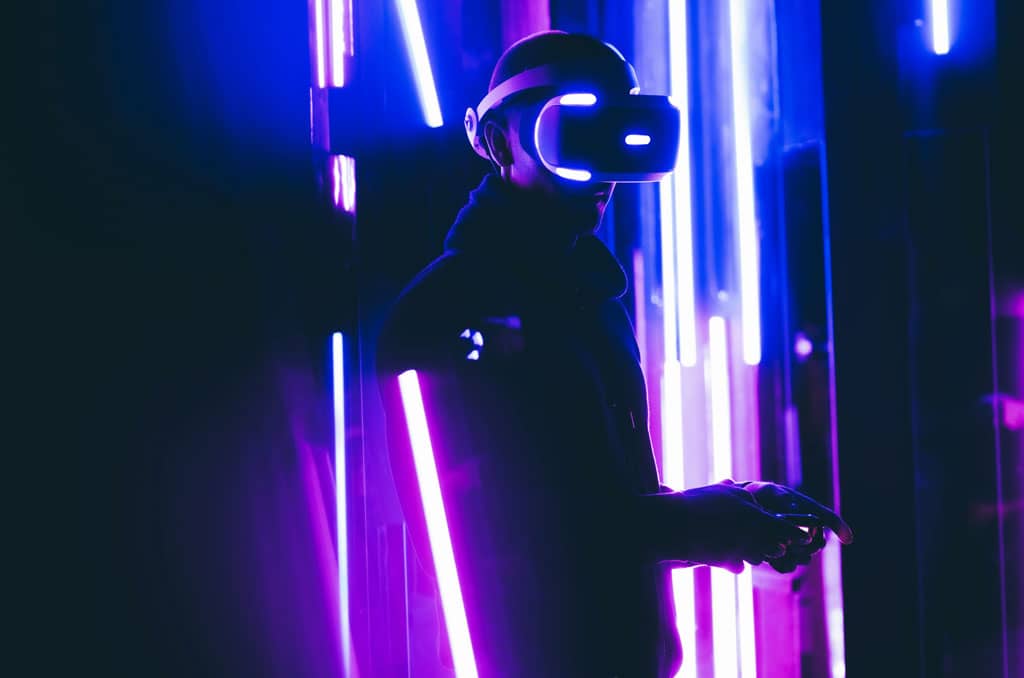
Next-Gen
Training video game industry professionals with virtual reality technology
This project aims to offer students training and professionalization in the video game and virtual reality sector. Next-Gen members have organized themselves into teams, replicating the structure of the Industry. A virtual reality tool has been developed to navigate through virtual art worlds, facilitating the analysis of complex artistic works.
The work is not limited to creating an immersive tool but also aims to promote balanced learning in multidisciplinary teams. The main objective of this program is to promote the culture of entrepreneurship and to provide “practical flight hours” to facilitate user entry into the professional world.
- Laura Raya (Project Director)
- Jaime Repollés (Classic Art Supervisor)
- Guillermo Tostón (Digital Art Supervisor)
- Guillermo Corcuera(Virtual Reality Supervisor)
- Cristina Roda (Former Master’s student in Computer Graphics and Simulation. RV Team Leader)
- Damián Perez (Former student with a degree in Animation. Animation Team Leader)
- Guillermo Miranda (Former student with a degree in Animation. Modeling Team Leader)
- Students of the Animation and Visual Design Degrees.
Support by:


